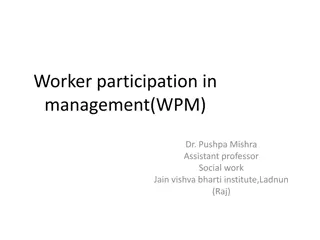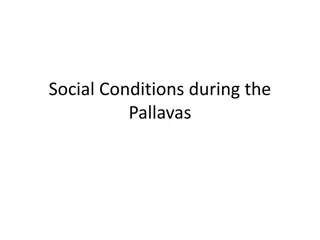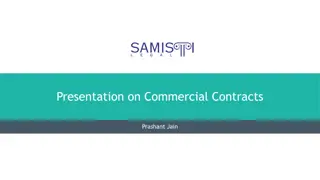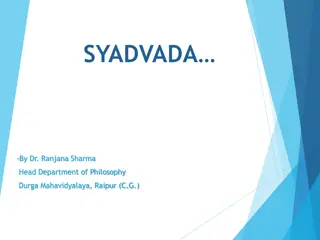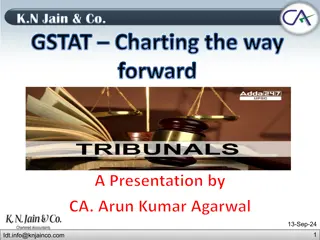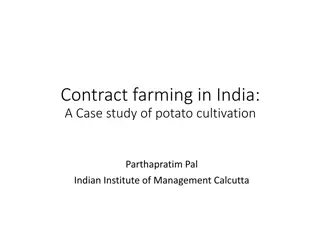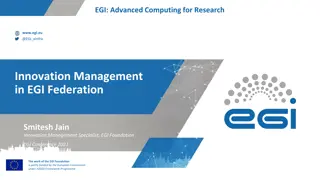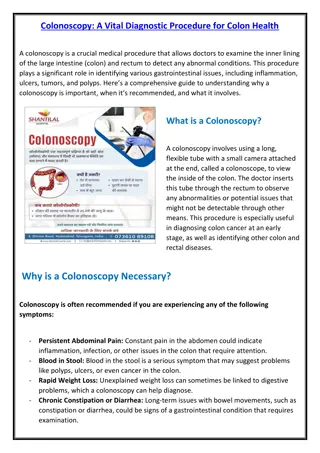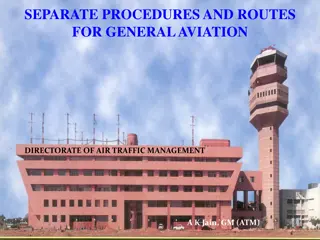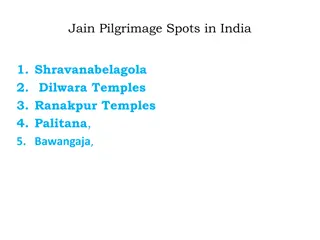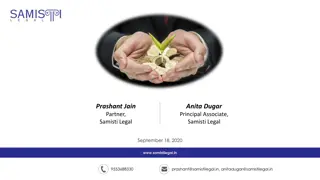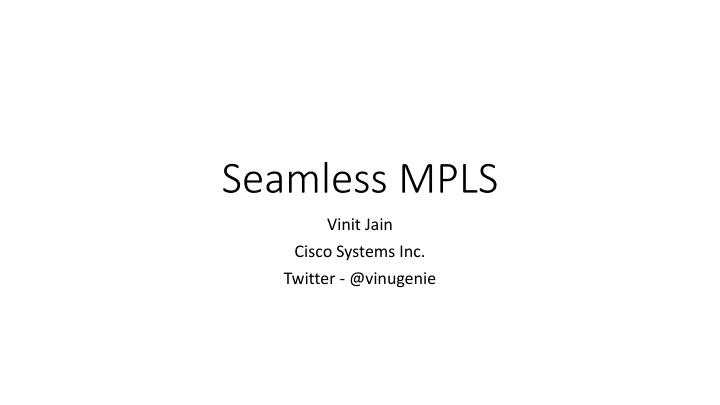
Efficient MPLS Transport Architecture for Mobile Networks
Explore the seamless operation of MPLS in mobile transport networks, addressing high capacity requirements, network convergence challenges, and service decoupling. Discover how MPLS optimizes service delivery, enhances network scalability, and integrates various access technologies for fixed and mobile services.
Download Presentation

Please find below an Image/Link to download the presentation.
The content on the website is provided AS IS for your information and personal use only. It may not be sold, licensed, or shared on other websites without obtaining consent from the author. If you encounter any issues during the download, it is possible that the publisher has removed the file from their server.
You are allowed to download the files provided on this website for personal or commercial use, subject to the condition that they are used lawfully. All files are the property of their respective owners.
The content on the website is provided AS IS for your information and personal use only. It may not be sold, licensed, or shared on other websites without obtaining consent from the author.
E N D
Presentation Transcript
Seamless MPLS Vinit Jain Cisco Systems Inc. Twitter - @vinugenie
Agenda Mobile Transport Market Conditions Seamless MPLS Overview Seamless MPLS Components Seamless MPLS Architecture Models Summary
Mobile Transport Market Conditions High Capacity requirements from Edge to Core 100Mbps eNB, 1Gbps Access, 10Gbps Aggregation, 100Gbps Core Higher scale as LTE drives ubiquitous mobile broadband Tens- to hundred-of-thousands of LTE eNBs and associated CSGs Support for multiple and mixed topologies Fiber and microwave rings in access, fiber rings, hub and spoke in aggregation and core networks Need for graceful service integration and integration into existing infrastructure Need to support transport for all services from all locations Optimized operations with consistent packet transport
MPLS as Network Convergence Technology MPLS as Network Convergence Technology Optimizing Service Delivery Access Aggregation Edge Core Cross-Domain Convergence IP/MPLS LS Challenges with differing Access technologies Complexity of achieving 50 millisecond convergence with TE-FRR Splitting large networks into domains while delivering services end-to-end Common end-to-end convergence and resiliency mechanisms End-to-end provisioning and troubleshooting across multiple domain Unified MPLS addresses these challenges with elegant simplicity and scale
Seamless MPLS Overview An efficient MPLS transport architecture Virtualized to support many services on one infrastructure Relying on an intelligent hierarchy to scale to new challenges Enabling seamless operation for network and service resilience Separating transport from service operations with single touch point service enablement and contiguous OAM Integrating alternate access technologies on same infrastructure while still enabling Fixed and Mobile Services
Seamless MPLS Operation Transport & Service Decoupling Operational Points LER LSR LER MPLS Unified MPLS Access AGG AGG AGG AGG Access MPLS MPLS Typically, a service has to be configured on every network element via operational points. The management system has to know the topology. Goal is to minimize the number of operational points Only with the integration of all MPLS islands, the minimum number of operational points is possible Service provisioning only at the Edge 6
Unified MPLS = Classical MPLS with a few additions Classical MPLS IGP/LDP Domain isolation RFC 3107 E2E OAM BGP filtering LFA R-LFA BGP PIC Flex Access L2/IGP/BGP/MPLS- TP/LDP DoD Unified MPLS Architecture Multi-Service Scalability Security Simplification
RFC-3107 RFC 3107 was approved May 2001, main purpose being scaling of MPLS RFC 3107 is BGP IPv4 with the ability to distribute labels BGP Filtering supported via BGP Communities in a secure manner RFC 3107 basis: BGP can be used to distribute MPLS labels in the same way it can distribute a route The label mapping information for a particular route is piggybacked in the same BGP Update message that is used to distribute the route itself. If two immediately adjacent Label Switched Routers (LSRs) are also BGP peers, then label distribution can be done without the need for any other label distribution protocol.
LFA & R-LFA What is LFA FRR? RFC 5286 basic fast re-route mechanism with local protection in pure IP and MPLS/LDP networks Pre-computing available paths at source node that do not create loops Gives benefits of TE-FRR, but no configuration or design required What is Remote LFA? Defined in draft http://tools.ietf.org/html/draft-shand-remote-lfa Remote LFA uses automated IGP/LDP behavior to extend basic LFA FRR to arbitrary topologies A node dynamically computes its remote loop free alternate node(s) Done during SFP calculations using PQ algorithm (see draft) Automatically establishes a directed LDP session to it The directed LDP session is used to exchange labels for the FEC in question On failure, the node uses label stacking to tunnel traffic to the Remote LFA node, which in turn forwards it to the destination
Remote LFA FRR - Protection C2 s LIB C1 s label for FEC A1 = 20 C3 s label for FEC C5 = 99 C5 s label for FEC A1 = 21 On failure, C2 sends A1-destined traffic onto an LSP destined to C5 Swap per-prefix label 20 with 21 that is expected by C5 for that prefix, and push label 99 When C5 receives the traffic, the top label 21 is the one that it expects for that prefix and hence it forwards it onto the destination using the shortest-path avoiding the link C1-C2. Backbone A1 A2 E1 C5 C1 Directed LDP session 20 21 C2 C4 21 C3 99 21 X 21 99 Access Region
BGP Prefix-Independent Protection (PIC)/BGP FRR BGP Fast Reroute (BGP FRR) enables BGP to use alternate paths Algorithm uses a pointer to move all prefixes to new next hop, not a hop by hop rewrite ~ 100 msec protection Prefix-Independent Default behavior, entirely automated computation Enables 3107 BGP+labels operation to scale via hierarchy while maintaining fast convergence characteristics For Transport and Service convergence
Unified MPLS Architecture Models Architecture Models based on: Access Type: Ethernet TDM or MPLS access Network Size: Small/Medium (1000 nodes or less) or Large End to Labeled Switch Path Deployment Model Network Size Access Type Core/Aggregation LSP 1 Small/Medium Ethernet/TDM Flat LDP 2 Small/Medium MPLS Hierarchical Labeled BGP 3 Large Ethernet Hierarchical Labeled BGP 4 Large MPLS Hierarchical Labeled BGP for Core, Aggregation and Access 5 Large MPLS Hierarchical Labeled BGP for Core, Aggregation with redistribution in Access
1 Small Network: Ethernet/TDM Access Flat LDP LSP across Core and Aggregation Networks Mobile Transport GW Core Node Core Node Aggregation Node CSG Aggregation Node IP/Ethernet Aggregation Node Core and Aggregation IP/MPLS Domain Pre-Aggregation Node Business Distribution Node Aggregation Node Aggregation Node Mobile Transport GW Core Node Core Node TDM and Packet Microwave, 2G/3G/LTE Fiber and Microwave 3G/LTE IGP/LDP domain Core and Aggregation Networks form one IGP and LDP domain. Scale recommendation is less than 1000 IGP/LDP nodes Packet Microwave links aggregated in Aggregation Nodes Mobile Access is based on TDM All services Mobile and Wireline enabled by Aggregation Nodes
2 Small Network: MPLS Access Hierarchical BGP LSP Across Core + Aggregation and Access Networks Aggregation Node Aggregation Node Mobile Transport GW Core Node Core Node CSG CSG RAN Core and Aggregation IP/MPLS domain IGP Area RAN IP/MPLS Domain Pre-Aggregation Node Pre-Aggregation Node IP/MPLS Domain CSG CSG Mobile Transport GW Core Node Core Node CSG Aggregation Node CSG Aggregation Node iBGP Hierarchical LSP LDP LSP LDP LSP LDP LSP The Core and Aggregation form a relatively small IGP/LDP domain (1000 nodes) MPLS enabled RAN, each RAN forms a different IGP/LDP domain The Core/Aggregation and RAN Access Networks are integrated with labelled BGP LSP The Access Network Nodes learn only the MPC labelled BGP prefixes and selectively and optionally the neighbouring RAN networks labelled BGP prefixes.
3 Large Network: Ethernet/TDM access Hierarchical BGP LSP Across Core Network and Aggregation Networks Aggregation Node Aggregation Node Mobile Transport GW CSG Core Node Core Node Aggregation Network IP/MPLS Domain Aggregation Network IP/MPLS Domain IP/Ethernet Core Network IP/MPLS Domain CSG Core Node Core Node Aggregation Node Pre-Aggregation Node Mobile Transport GW Aggregation Node Aggregation Node TDM and Packet Microwave, 2G/3G/LTE Fiber and Microwave 3G/LTE iBGP (eBGP across ASes) Hierarchical LSP LDP LSP LDP LSP LDP LSP Core and Aggregation Networks enable Unified MPLS Transport Core and Aggregation Networks are organized as independent IGP/LDP domains Core and Aggregation Networks may be in same or different Autonomous Systems The network domains are interconnected with hierarchical LSPs based on RFC 3107, BGP IPv4+labels No MPLS in Access Domain Aggregation Node enable Mobile and Wireline Services over Unified MPLS transport.
4 Large Network: MPLS Access Hierarchical BGP LSP Across Core, Aggregation and Access Networks Aggregation Node Aggregation Node Mobile Transport GW Core Node Core Node CSG Core Node Core Node CSG RAN IP/MPLS domain Aggregation Network IP/MPLS Domain Aggregation Network IP/MPLS Domain RAN IP/MPLS domain Core Network IP/MPLS Domain CSG Pre-Aggregation Node Core Node Core Node Pre-Aggregation Node CSG Mobile Transport GW Core Node Core Node CSG Aggregation Node CSG Aggregation Node iBGP (eBGP across ASes) Hierarchical LSP LDP LSP LDP LSP LDP LSP LDP LSP LDP LSP Core, Aggregation, Access Network enable Unified MPLS Transport Core, Aggregation, Access are organized as independent IGP/LDP domains Core and Aggregation Networks may be in same or different Autonomous Systems Network domains are interconnected with hierarchical LSPs based on RFC 3107, BGP IPv4+labels. Intra domain connectivity is based on LDP LSPs The Access Network Nodes learn only the required labelled BGP FECs
5 - Large Network, MPLS Access Hierarchical BGP LSP with IGP/LDP Redistribution in Access Network Aggregation Node Aggregation Node Mobile Transport GW Core Node Core Node CSG MPC iBGP community into RAN IGP Core MPC iBGP community into RAN IGP Core Node Core Core Node CSG Aggregation Network IP/MPLS Domain Aggregation Network IP/MPLS Domain RAN MPLS/IP RAN MPLS/IP Core Network IP/MPLS Domain Pre-Aggregation Node RAN IGP CSN Loopbacks into iBGP Pre-Aggregation Node CSG IGP Area/Process IGP Area/Process Core Node Core Node CSG Mobile Transport GW Core Core Node Core RAN IGP CSN Loopbacks into iBGP Core Node CSG Aggregation Node CSG Aggregation Node i/eBGP Hierarchical LSP LDP LSP LDP LSP LDP LSP LDP LSP LDP LSP Core and Aggregation are distinct IGP/LDP domains that enable inter domain hierarchical LSPs Core and Aggregation Networks may be in same of different Autonomous Systems Redistribution of Core/Aggregation LSPs into Access Networks IGP
Sample End Sample End- -to to- -End Unified MPLS Architecture End Unified MPLS Architecture Routing Isolation and Label Stack for LSP between Pre-Agg. Node Loopbacks Aggregation Network Aggregation Network Access Network Access Network Core Network Core ABR (Inline RR) Core ABR (Inline RR) MPC Gateway Pre-Agg. Node Agg. Node Agg. Node Pre-Agg. Node L2 ISIS Level 1/OSPF x ISIS Level 2/OSPF 0 ISIS Level 1/OSPF x L2 Access Node Core ABR (Inline RR) Pop Access Node Core ABR (Inline RR) Pop Agg. Node Centralised RR Agg. Node IGP/LDP Label Swap Push Push Swap Push Swap BGP3107 Label Swap Pop Swap Service Label LDP LSP LDP LSP LDP LSP BGP LSP No IGP route is propagated from Aggregation to the Core. IGP area has routes for that area only plus routes to core ABRs. Only the core ABR s are propagated from L2 to L1 LDP labels are used to traverse each domain and reach core ABRs BGP labels are used by Labeled BGP PEs & ABRs to reach Labeled BGP PEs in remote areas Service (e.g. PW) labels are used by Label BGP PEs
Unified MPLS Architecture Unified MPLS Architecture Summary Aggregation Layer Access Layer Simplified MPLS Transport with E2E OAM, performance management, provisioning with seamless resiliency Pre-Aggregation Layer PGW SGW Cell Site Core Layer Distribution node Core node Aggregation node Cell site Router Sample Routing Architecture FlexibleL2 & L3 transport virtualisation to support GSM, 3G & LTE, wholesale & retail options iBGP/eBGP Aggregation Node EPC Gateway Core ABR Pre-Aggregation Node Access Node Access Network Aggregation Network Core Network Core ABR Access Node New levels of Scale for MPLS transport and optimal routing through RFC 3107 with BGP hierarchical LSPs Centralised RR Aggregation Node IGP/LDP IGP/LDP IGP/LDP L2

